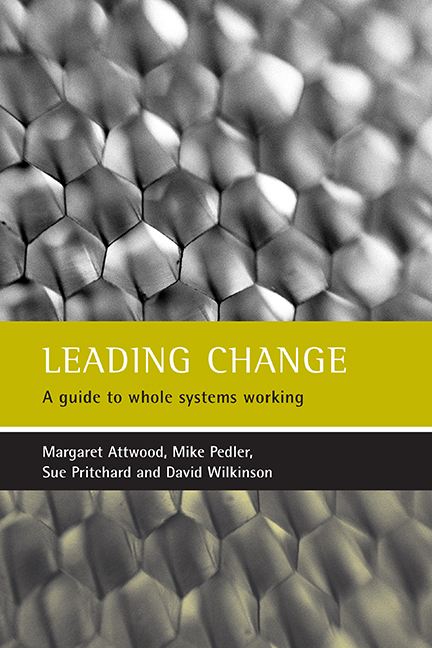Book contents
- Frontmatter
- Contents
- Foreword
- Foreword
- Prologue
- one Why do we need whole systems change?
- Two How Do We Put These Fine Words Intoaction? An Overview of Whole Systems Development
- Three The emerging practice of wholesystems development
- Four Leadership: keeping the big picture in view
- Five Public learning
- Six Valuing difference and diversity: getting the whole systeminto the room
- Seven Meeting differently: large and small group working
- Eight Follow-through and sticking with it
- Nine From organisations to networks
- Ten Confirming cases: local problems andlocal solutions within whole systems
- Epilogue
- Bibliography
- Index
Eight - Follow-through and sticking with it
Published online by Cambridge University Press: 20 January 2022
- Frontmatter
- Contents
- Foreword
- Foreword
- Prologue
- one Why do we need whole systems change?
- Two How Do We Put These Fine Words Intoaction? An Overview of Whole Systems Development
- Three The emerging practice of wholesystems development
- Four Leadership: keeping the big picture in view
- Five Public learning
- Six Valuing difference and diversity: getting the whole systeminto the room
- Seven Meeting differently: large and small group working
- Eight Follow-through and sticking with it
- Nine From organisations to networks
- Ten Confirming cases: local problems andlocal solutions within whole systems
- Epilogue
- Bibliography
- Index
Summary
A friend used to tell the story of a great African river that started high in the mountains and became a rushing torrent sweeping all before it; but when it came to the plain, its momentum slowed and it split into many rivulets on the flat land. Soon it became a huge swamp and the mighty river had disappeared. Change efforts often start with great momentum, as attempts to tackle previously intractable problems, but then, as time passes and the terrain changes, energy for these efforts dissipates.
This analogy, however, can be viewed somewhat differently in whole systems terms. As those who took O level Geography will recall, it is the force of the river in its early course that creates steep valleys; as the river grows in volume, its energy disperses and it meanders to the sea. But the energy does not disappear. A feature of meandering rivers is the oxbow lake – a deep bend in the river, which becomes isolated as the river takes the shortest course. And of course, it is in the rich river floodplains and deltas that agriculture does best. So the river does what it needs to do to meet the sea, bending around obstacles,and can look very different in appearance from the mountain stream to the broad delta. But it is all part of a connected cycle of rainfall, water catchment,coastal and ocean systems.
In whole systems terms, follow-through is inextricably linked with the challenge of implementation, of getting things done and generating change in the long term. It does not have the same connotations as follow-up (the odd meeting to catch up with progress), rather it carries with it the somewhat old-fashioned virtues of persistence, resilience and sticking with it, alongside the more modern attributes of sensitivity to, and awareness of, the changing character of the environment in which we operate. So by follow-through we mean allof those activities and processes that help bring about change, translate strategyinto actions and make a difference. Importantly, follow-through is not a fixedtop-down process; it is an organic, dynamic process intimately connected tothe circumstances and context in which the change challenge takes place.
In this chapter, we:
• introduce and develop the idea of change architecture;
• develop the links between change architectures, the Five Keys and the otherimportant principles for leading change developed in Chapter Three (holding frameworks, middle-ground frameworks and widening circles of inclusivity);
• reiterate and develop the role and purpose of action learning within wholesystems processes;
• emphasise the continuing importance of creating ‘memories of the future’ through scenario building and wider inclusion;
• connect to the last two chapters on the newer forms of organising andworking towards local solutions with wider whole systems.
- Type
- Chapter
- Information
- Leading ChangeA Guide to Whole Systems Working, pp. 131 - 142Publisher: Bristol University PressPrint publication year: 2003



